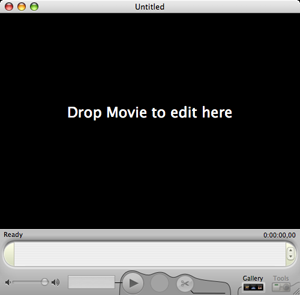Software Review
SimpleMovieX 3.0

Developer: Aero Quartet
Price: $30
Requirements: Mac OS X 10.3.9, QuickTime 7. Universal.
Trial: Fully-featured (slower saving)
- You have a digital camera that can double as a camcorder so you use it frequently to record five-minute clips of your kid doing cute things. Eventually, you need to assemble them into a movie to show to the kid’s technically-challenged grandparents.
- You have TiVo and have shelled out the money to be able to convert the recordings to MPEG-4. Now you need to quickly remove the commercials.
- You are a Stephen Colbert fan and want to take up his Video Challenge so you need something that can quickly move chunks of video clips around.
With SimpleMovieX from Aero Quartet, the needs in these scenarios can be fulfilled. Installation of SimpleMovieX, or SMX for short, is a simple matter of mounting the image file and copying the program to the Applications folder. When launched, SMX presents you with the message “Drop Movie to edit here.”

Below the main window is a holding area, called the Gallery. As a movie is loaded, it appears in the Gallery, and a few controls appear in the main window.

For simple editing, all the work can be done with the controls in the main screen. You have the big Play button to play back the clips. Using the copy-and-paste metaphor of a word processor, you select a segment of the movie by adjusting the white and the blue controls. Actually, the segment end that you adjust instantly turns blue as you select and drag it, so it seems like you don’t really move the white knob. With the target segment selected, you can copy and paste them via keyboard commands Command-C and Command-V or from the menu bar at the top. Command-X or its corresponding menu command would cut the selected segment from the movie, but since cutting is a frequently-used action in film editing, SMX conveniently has a button, labeled with a picture of a scissor, right in the main window.
Editing a movie isn’t as easy as moving chunks of text in a word processor. You don’t really see the selected movie segment but merely a representation of it on the time line. To give you extra, finer control of the process, SMX provides zooming, audio waveform, and a search window.

Using the up and down arrows in the main window, you can zoom up to 900× into a movie segment to select just the frame to serve as the beginning or end of a segment. You can also use the left and right arrow keys on the keyboard to move one frame at a time. To control by sound, enable the display of the waveform overlay. Now you can precisely capture those sound bites exactly based on where the wave goes flat. Lastly, by exposing the Tools pane, you can visualize the selected segment in terms of frames. Instead of fast forwarding to the place where you want the marker to be, you click on one of the still frame in the grid. The number of still frames to be scanned can be 16 or 64.
SMX has one advanced feature that can be attractive to TiVo owners. As long as you can somehow convert the TiVo downloads into MPEG-4, SMX will happily load them. Using SMX’s new chapter feature, you can divide the movie into, well, chapters. On the time line, the chapters are labeled alternately as blue and white chapters so with a built-in script, you can easily remove all the commercials in one fell swoop.
I am not a TiVo owner but I do have a need that SMX helps greatly. My wife plays the Chinese zither in a local musical group. From time to time, they would perform at concerts and I record the shows. I do not care for the DVD format’s menu system and prefer that my movie discs play immediately upon being inserted in a playback device. I store the concert movies in the Video CD (VCD) format. VCD files are in MPEG-1 format, and even though quality is at best VHS, VCD discs take less time to burn, lack DVD’s menu system, and play immediately upon insertion.
To separate the music from the movie, up to now, I had to use Audacity and Griffin’s iMic—somewhat of a low-tech solution, and I usually end up adjusting the volume a few times before I can get the music right. Now, with SMX, I can cut out the concert segment with the tune I want, then extract the audio out to an AIFF file. I still use Audacity to export the tune to MP3 for import into iTunes, but the extraction process is much simpler and more reliable.
I don’t do any movie editing at all and don’t own QuickTime Pro, either. If I want to extract an audio track out of a movie I would try the task with iMovie. Alas, before any movie files can be used by iMovie they would have to be first imported into iMovie. The import process takes minutes to complete, but is long enough to derail the train of thought that carries my artistic vision. In the case of VCD files, iMovie cannot even import the .DAT files, a mere few hundred megabytes in size. iMovie complained that I didn’t have enough space for the import process, even though I did have 4 GB of free space.
SMX has many more advanced features, but you are on your own when you get there as SMX’s documentation has a gaping hole in advanced editing. With the common use of online documentation, I wasn’t surprised that the SMX help file has links to the Web for advanced editing. Alas, when I went to the Aero Quartet Web site, there was nothing much on advanced editing, either. The page is under construction. To its credit, the SMX documentation does disseminate the difference between codecs, such as MPEG-1, and containers, e.g. QuickTime and includes links to Wikipedia.
SMX bills itself as “The happy QuickTime Pro replacement that does MPEG.” Its list of reasons to switch from QuickTime Pro includes native support for MPEG-1, MPEG-2, and AVI. To the list, I would add free/discounted upgrades and more reliability. One major complaint QuickTime Pro owners have is that every new version of QuickTime Pro costs $30, regardless whether you bought it before or not. What’s worse, when QuickTime Player 7 came out, installing it would disable QuickTime Pro 5 or 6’s Pro features. With shareware like SMX, chances are you’ll get free upgrades for a long time to come.
Overall, SMX works smoothly but I’ve found two somewhat annoying bugs. If, instead of dropping files into its window, you use Command-O, in the selection window you would not be able to double-click a file to select it. You would have to press the Enter key on the keyboard or click the Open button. The other bug is that if you go into full-screen mode, then use Command-Tab to switch to another application, when you Command-Tab again to return to SMX, the movie goes back to its normal size and continues playing, but with SMX’s blank default screen. You would have to go into full-screen mode again or select a screen size from the menu bar.
Incomplete documentation and a few bugs aside, I still think SimpleMovieX is a solid product. As I do not own QuickTime Pro, I cannot say that it makes a good replacement, but for my light movie editing needs, its feature set is just right. I give it a Very Nice rating.
Reader Comments (0)
Add A Comment